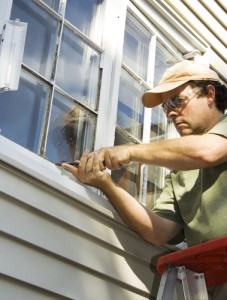Air leaks in the home’s envelope wastes energy, creates uncomfortable drafts and increases the heating or cooling load placed on the HVAC system. Weatherizing your home solves these issues and plugs the leak on your energy budget. Keep reading to learn simple and practical home weatherizing tips.
Weatherizing Your Home
You’re going to need basic air sealing products, such as various types of caulk, weatherstripping and gaskets. Perform a walk-thru of your home. Write down the number of wall switches and outlets on inner and outer walls. Write down any comfort problems in your home, such as drafty windows and doors, and uneven temperatures.
Next, search for air leaks using a lit incense stick or smoke pencil. Hold the incense stick or smoke pencil to all areas susceptible to air leaks, which are basically any place where two different home materials meet. If the smoke from the incense stick or smoke pencil wavers, you’ve found an air leak. Take a trip to the home store to pick up air sealing supplies.
Leaky Doors and Windows
- Exterior doors are prone to air leaks, especially older doors and wooden doors that expand and contract through the seasons. Tubular vinyl or rubber foam weatherstripping works great to seal leaky doors. Door sweeps stop leaks at the bottom.
- If you have an attached garage, make sure it’s tightly sealed too in order to prevent harmful gases and contaminants entering the living space. Install a carbon monoxide (CO) detector at least 10 feet of the door.
- Seal window frames with caulk. Silicone caulk is flexible and lasts longer than latex caulk. However, silicone caulk can’t be painted. A low-profile thin line of clear silicone caulk can do the trick sealing tiny cracks around window framing. Foam weatherstripping works well for the top of window sashes. Plastic tension v-strips seal leaks well for double-hung windows.
- Make sure all windows open and close securely and tightly. Check all locks. Replace any cracked or broken glass.
Attic Sealing
With temperature extremes, protruding roofing nails and, perhaps, no flooring to walk safely, attics can be dangerous places in the home. Use caution and dress appropriately when going into the attic. Following are common areas in the attic to check for air leaks:
- Door or hatch: Tightly sealing the attic hatch is important for weatherizing your home. Use self-adhesive foam weatherstripping to seal the door or hatch. Fiberglass batts or rigid foam board should be applied to the back of the door or hatch.
- Recessed lighting: Use caulk or a can of spray-in foam to seal cracks and gaps around lighting. Read labels carefully, and make sure all caulk and spray-in foam are safe around wiring and heat.
- Piping and wiring: Caulk and spray-in foam may be used around piping and wiring.
- Open wall cavities: If wall cavities open into the attic, look inside and check for insulation. Loose fill works well in this situation.
- Attic floor: Attics in the Frisco and Allen areas should be insulated R-30 to R-60, which is approximately 10 to 20 inches of fiberglass or cellulose insulation.
Wall Switches and Outlets
Remember all the wall switches and outlets you counted? These areas can allow air infiltration from the attic and outside the home. You’ll need a screwdriver to remove the covers. Look inside the walls to check for insulation while the covers are off. If none exists, consult your HVAC contractor for advice on insulating existing walls. Now, install foam insulating gaskets in the wall openings. Insert childproof safety caps in unused outlets. Do the same for any switches and outlets on exterior home walls.
Wood Fireplaces
Wood fireplaces are common sources for air leaks. One of the best solutions for stopping air from escaping or entering the home through the fireplace is installing tight-fitting glass doors. Always keep the damper door closed when the fireplace isn’t being used. If you don’t use the fireplace at all, plug up the chimney with insulation. Seal the glass doors shut with silicone caulk.
Energy Audit
If you’re seeking more comprehensive home-efficiency upgrades, consider bringing in a HVAC contractor to perform a whole-house energy audit. This evaluation will look at how and where your home uses energy, detailing where energy is being wasted, as well as where energy efficiency and conservation efforts can be improved.
Learn more about weatherizing your home from Bill Joplin’s Air Conditioning & Heating or contact us today at 888-414-4655 to schedule an appointment with an HVAC expert.





